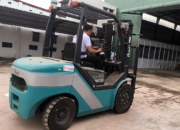Hydraulic Oil for Forklifts
Hydraulic oil used for forklifts is a special type of oil designed to work in the hydraulic system of a forklift. This type of oil provides lubrication and power transmission to hydraulic components, ensuring smooth and efficient operation.
When choosing hydraulic oil for a forklift, there are several important factors to consider:
- Viscosity: Hydraulic oil must have the appropriate viscosity to ensure effective operation of the hydraulic system. Viscosity is determined by the viscosity grade (ISO VG) or the cSt (centistokes) number. Typically, forklifts will require hydraulic oil with a viscosity ranging from ISO VG 32 to ISO VG 68.
- Lubricating properties: Hydraulic oil must have good lubricating properties to reduce friction and wear of components in the hydraulic system. This helps increase the lifespan of the system and ensures stable operation.
- Oxidation resistance: Hydraulic oil needs to have good oxidation resistance to prevent the formation of deposits and the degradation of oil performance during use.
- Anti-foaming properties: Hydraulic oil must have anti-foaming properties to ensure that the system’s performance is not compromised by the presence of air bubbles.
- Compliance with technical requirements: Ensure that the hydraulic oil you choose complies with the specific technical requirements of the forklift manufacturer you are using.
Note that forklift manufacturers may have specific requirements for the type and specifications of hydraulic oil, so it’s best to consult the user manual or contact the manufacturer for detailed information on the appropriate hydraulic oil for your forklift.
When to change hydraulic oil for forklifts
The timing for changing hydraulic oil for forklifts may vary depending on the manufacturer’s recommendations and the specific operating conditions of the vehicle. However, here are some general guidelines to determine when to change hydraulic oil:
- Follow the maintenance schedule: Forklifts usually have a regular maintenance schedule prescribed by the manufacturer. This schedule will indicate the specific timing for changing hydraulic oil. Check the user manual or contact the manufacturer to know the maintenance schedule for your forklift.
- Based on operating hours: A common method to determine when to change hydraulic oil is based on the operating hours of the forklift. The manufacturer typically recommends a specific number of operating hours (e.g., after 1000 hours) for oil change. Refer to the user manual or inquire with the manufacturer for the recommended operating hours.
- Check oil quality: Another way to assess the timing for changing hydraulic oil is to check its quality. Hydraulic oil after a period of use may become oxidized, contaminated, or lose viscosity. If the oil appears cloudy, has abnormal color, or has an unusual odor, it may be a sign that it needs to be replaced. Check the level and condition of the hydraulic oil according to the manufacturer’s instructions or consult with a professional technician.
- Based on working conditions: If your forklift operates in harsh environments or requires high power, you may need to change hydraulic oil more frequently than a forklift operating under lighter conditions.
SamcoVina Corporation provides repair and maintenance services for forklifts
SamcoVina Corporation, a leading company in the field of forklift repair and maintenance, is proud to announce its high-quality services to meet the increasing demand for forklift maintenance and repair.
With over 15 years of experience in the industry, SamcoVina has built a reputation for its professional technicians and modern technology to ensure customers receive the best services. The company is committed to providing high-quality repair and maintenance solutions that ensure the stable and efficient operation of forklifts.
Here are the key benefits of choosing SamcoVina as your partner for forklift repair and maintenance:
Professional technical team: With a team of experienced technicians, SamcoVina guarantees high-quality repair and maintenance services. Our experts are extensively trained in forklifts and have the ability to handle complex technical issues.
State-of-the-art equipment: SamcoVina uses the latest tools and equipment to perform repair and maintenance services. This enhances diagnostic capabilities and allows for quick identification of faults, ensuring efficient and prompt repairs.
Reliable service quality: SamcoVina is committed to providing reliable service quality. We use high-quality components and adhere to strict quality control processes to ensure the stable and safe operation of forklifts.
Diverse range of services: SamcoVina offers a range of repair and maintenance services for forklifts, including regular maintenance, troubleshooting and repair, system upgrades and improvements, supply of genuine parts and accessories, and more. We have the ability to meet diverse customer requirements.
On-site and flexible services: SamcoVina understands that time is crucial in forklift repairs. Therefore, we provide on-site services that are flexible and prompt. Our technicians can come to the customer’s location to perform repair and maintenance services.
With a commitment to quality, professionalism, and dedicated service, SamcoVina is a reliable partner for forklift repair and maintenance. Contact us today for more detailed information and the best advice for your needs.
Contact information: SamcoVina Corporation Address: 26/11 Dai Lo Binh Duong, Khu pho Trung, Phuong Vinh Phu, Thuan An Town, Binh Duong Province Email: info@samcovina.com Website: www.samcovina.com







